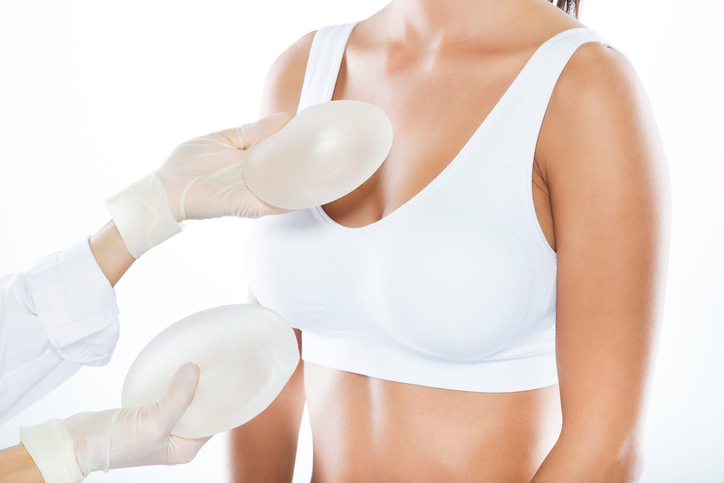Breast Augmentation
Overview
 If you want to enhance the size, contour, and feel of your breasts, breast augmentation surgery may be right for you. The goal of breast augmentation is to use implants to create fuller, more natural-looking breasts to boost your self-confidence and to give your clothes a better fit.
If you want to enhance the size, contour, and feel of your breasts, breast augmentation surgery may be right for you. The goal of breast augmentation is to use implants to create fuller, more natural-looking breasts to boost your self-confidence and to give your clothes a better fit.
Also called breast enlargement surgery, the procedure will:
- Increase breast size in women who feel their breasts are too small
- Increase breast volume that has been lost as a result of aging, weight loss, or breast feeding and pregnancy
- Correct slightly sagging breasts (For most women with noticeable sagging breasts, however, a Breast Lift or Breast Lift With Implants is required)
- Restore breasts to a normal appearance after mastectomy (see Breast Reconstruction)
Breast augmentation used to be very painful during the first few days of recovery. At Summit Health, we have developed a set of protocols to limit the pain and discomfort from this procedure. These protocols involve providing medications before, during, and after the breast augmentation procedure, as well as optimizing our patient care. We also use nerve block techniques to numb the area of the operation before we even start it. As a result, most of our patients tell us that they only require minor quantities of pain medication for a couple of days. Some patients take no pain medications at all!
Since we perform a large number of breast reconstruction surgeries after breast cancer, we are very familiar with the problems that can come up in the short term or long term after breast implant surgery. These include breast implant deflation (rupture) and capsular contracture (also known as “Cap Con”). This has allowed us to develop safeguards to avoid such complications.
“I recently had cosmetic surgery with Dr. Hyans. I was extremely nervous about the whole process, but his extensive knowledge and the ease that he and his staff put me at, helped me move forward with breast augmentation. I am more than happy with only one regret … that I didn’t do it sooner.”
Ready to get started?
Breast Augmentation Procedure
When you meet with us for your breast augmentation consultation, we will have an honest discussion about your desires, expectations, and concerns, as well as the limits and risks of the surgery. We will review your medical history and recommend options that can best help you achieve your goals. We will give you thorough written instructions to prepare for your breast augmentation surgery and will answer any questions you have.
At the Summit Health Plastic Surgery Center, the patient experience is of primary importance to us. We do not believe in one-size-fits-all plastic surgery, so we customize every single treatment, tailoring it to what is best for you and you alone. With breast augmentation, there are many decisions to be made, such as the size, shape and type of implant. We will provide you with the pros and cons of each as they relate to your particular case.
Our overall philosophy is to provide a natural look. We don’t want any of our patients to look like they have had breast augmentation surgery. We prefer not to use disproportionately large breast implants that are out of proportion to the patient’s body (and are also known to have a higher risk profile).
We provide real-life breast implants for you to see and sizers for you to try out in our office prior to having breast augmentation so that you can be sure that you have chosen the best implant size for you. We also use a biodimensional planning system, which means that we custom-fit the dimensions of the breast implant based on the dimensions of your body.
During your breast augmentation consultation, we will take a number of anatomical measurements with respect to your breast and chest. The keystone measurement is the breast width. An implant that is significantly wider than your natural breast width will look strange (causing the breast to bulge out on the outside of the chest and perhaps even making the breasts touch together in the middle), while a narrower implant than your natural breast width will tend to look abnormal, much like a tennis ball in a sock. If you choose an implant width that is significantly wider than your own, symmastia (uniboob) could result. Biodimensional planning shows us if a particular size of breast implants will look distorted and unnatural on your body type based on your anatomical measurements.
This planning takes into account the height of the breast, shape, height of the nipples, size of the areolas, bulk of the pectoral muscle, and thickness and stretch of the soft tissue. By doing this intricate pre-planning, you will feel more confident that your breast augmentation results will be to your liking.
Most women don’t realize that size is just one consideration in breast augmentation. If your sister has 360cc implants and her breasts look great, it doesn’t mean that same implant will look equally great on you. Think of it this way: A person can weigh 150 pounds, but how that weight looks will depend on the person’s height and build. 150 pounds looks very different on someone who is 4’3” than someone who is 6’2”. The same principle applies to breast implants. So, your anatomy must be taken into account when choosing a size.
Height and projection are also important measurements to consider for breast augmentation. Projection refers to how much of the breast projects outward from the body while in profile. Fuller implants have a higher projection, while more natural-looking breasts have a slightly lower projection.
Shape is another necessary breast augmentation factor to consider. Round implants offer more cleavage and better fill for the upper pole of the breasts, but a less natural look if the chosen implant is large. Teardrop-shaped implants look more like natural breasts in larger sizes.
We offer all three types of implants – saline, standard silicone gel, and advanced gummy bear (also known as form-stable silicone gel). We do not have a particular preference for one over the over, since no implant is necessarily better than all others for all patients. Comparing them is like comparing a BMW to a Mercedes – it’s simply a matter of preference and how they fit a person’s anatomy. If one type of breast implants were better than all the others, everyone would use just that type of implant.
|
Type of Implant |
Pros |
Cons
|
|
Saline Implants (FDA-approved for women age 18 and over) |
Less expensive. |
Come only in a round shape, not as many size options. |
|
Less complicated. |
In thin patients with little tissue over the implant, they may feel less natural.
|
|
|
No monitoring required. If they leak or rupture, you will know within 2-3 weeks. There is no detection mechanism needed to determine the rupturing and no concern about salt water in the body.
|
Slightly more prone to rippling, which is both visible and palpable. |
|
|
Require a smaller incision because the shell is inserted and then inflated with the saline solution.
|
|
|
|
Silicone (FDA-approved for women age 22 and over) |
Have a natural feel, even in women who have worn an AA cup bra and will have little natural tissue over the implant. (In women with larger natural breasts, it is the tissue that is felt, not the implant.)
|
More expensive than saline. |
|
Come in a variety of shapes other than round with more customizable possibilities.
|
You cannot tell easily if they rupture, so every few years, you should get an MRI to determine if a rupture has occurred. |
|
|
Less prone to rippling. |
A slightly larger incision is required (than for saline) since the implants are filled and sealed by the manufacturer, but the incision difference is not significant.
|
|
|
Gummy Bear Implants (FDA-approved for women age 22 and over) |
Since gummy bear implants are silicone-filled, they have the same pros and cons as regular silicone implants.
|
Most expensive implant. |
|
|
Called “cohesive” because the silicone used holds its shape and does not move within the implant’s shell. |
Some of these implants feel firmer to the touch. |
Each type of implant has pros and cons, and which one is best for you will have a great deal to do with your anatomy, as well as how you wish your breasts to look and feel after your breast augmentation surgery.
Just as all aspects of your breast augmentation surgery are customized, the location of your incisions is also tailored for your anatomy, medical history, and preference. Incisions can be placed under the armpits (transaxillary incisions), around the areolas (periareolar incisions), or under the crease of the breasts (inframammary incisions). We perform breast augmentation surgeries using all of these incisions. Although 90% of our surgeries are done with incisions under the breast crease, and 10% are done with armpit or areola incisions. The reason is that in most patients, this is the nicest location to hide the incision from view after having breast augmentation.
We do not perform breast augmentation using the belly button (navel) incision. Breast implant warranty may not be honored with this method, and we have concerns about whether the longevity and symmetry of the implants are satisfactory when using this incision. The inframammary (under the crease) incision is preferable in most cases because it is a slightly less bacteria-prone method. For women without a history of keloid scars, the slight scar under the breast crease is minor after healing has taken place. That said, transaxillary and periareolar incisions are absolutely safe with the proper surgical protocols. They are preferable for women without a naturally defined fold under the breast or those who are prone to scarring, as the area around the areola is less prone to scarring, and the armpit scar is well-hidden.
Breast augmentation is an outpatient procedure conducted in our on-site surgery center or at the surgery center of our area hospitals. General anesthesia is used in most cases to optimize the surgical outcome, but in select cases and for the right patients, local anesthesia and intravenous sedation can be considered as an option. Breast augmentation surgery typically lasts about 1 hour.
During the breast augmentation surgery, a pocket is created within the breast, and the implant is placed either behind or in front of the pectoral muscle. This is another customized aspect of your surgery that we will discuss with you beforehand. Most breast implants have either subglandular (under the breast, above the muscle) or submuscular (under the breast and under the muscle) placement. The submuscular approach is also called subpectoral. Since the pectoral muscle doesn’t cover the full base of the breast, the lower bottom portion of the implant is not under the muscle even in submuscular (subpectoral) breast implant placement.
Subglandular breast implant placement is over the pectoralis major muscle. In this case, there is less tissue between the skin and the implant, so it works best with silicone implants that have a natural feel. Submuscular placement means that the implant is positioned under the pectoralis major muscle. Depending on your individual anatomy, we will recommend one placement over the other and will explain the reasons why it is preferable in your case.
After the breast implants have been properly placed, the incision is closed with dissolvable stitches, and you can go home a few hours later.
Breast augmentation recovery time is shorter than in the past. Due to the pain control protocols that we have put into place, most women are able to sit up with family and have dinner the same night as their breast augmentation surgery and go to the store the next day. The majority of our patients can return to work within 2-3 days, as long as the work is not physically taxing.
You will be given written instructions to recover from your surgery. The instructions will include ways to prevent infection and how to care for the bandages that are applied after your breast augmentation surgery. You will see your plastic surgery team in follow-up visits to make sure you are healing properly.
After breast augmentation surgery, you may feel sore for several days. If necessary, you can take oral over-the-counter or prescription medications. Most women only feel the need to take pain medication for a couple of days. Bruising is usually minimal, but swelling can last for several weeks. For this reason, you will not be able to see the final results of your breast enhancement for a few weeks. You will, however, see an immediate difference in the appearance of your breasts. The scar will flatten and fade over the first year in most cases.
You will be asked to wear a surgical soft support bra and limit vigorous exercise for a few weeks after having your breast augmentation procedure. You’ll find it more comfortable if you avoid lifting anything heavy and sleep on your back for about a month. If you are accustomed to sleeping on your stomach, pillows can help to keep you from turning over in your sleep. Regular examinations and routine mammograms can help ensure that any complications related to breast augmentation are detected and treated early.
Breast implants do not have to be removed and exchanged unless you develop a problem. Many implants last 10-20 years. Most women are thrilled with the results of their breast augmentation surgery.








